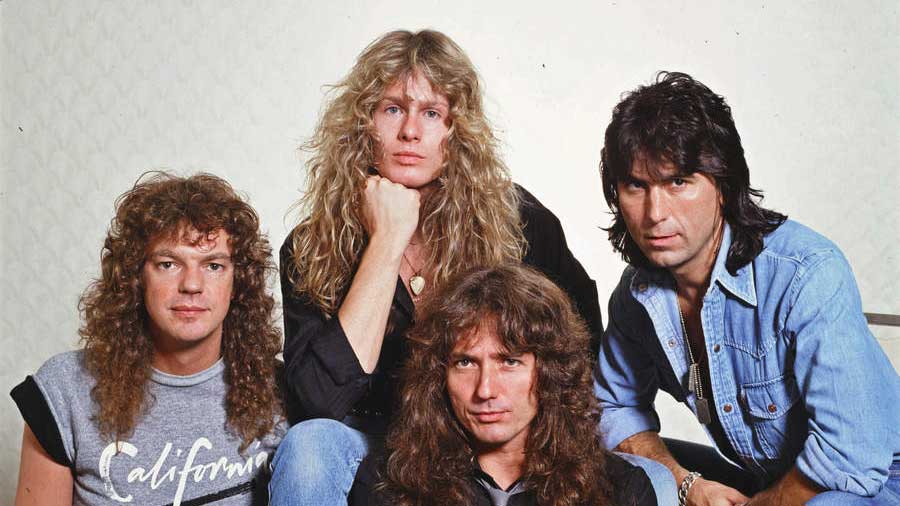
Whitesnake entered 1984 on a high, having headlined the Monsters Of Rock Festival at Castle Donington the previous summer, where their backstage area was decked out in the style of M*A*S*H, complete with barbed wire, sandbags, and security staff wearing army khaki. The band – David Coverdale’s so-called ‘Whitesnake Commandos’ – were leaving blues rock behind, and their sixth studio album, Slide It In, introduced some new faces in former Trapeze guitarist Mel Galley, bassist Colin ‘Bomber’ Hodgkinson and drummer Cozy Powell.
By the time Slide It In was released in the UK in January ’84, Neil Murray, Whitesnake bassist 1978 to 1982, had replaced Hodgkinson. At Donington, Murray had been discreetly sounded out over his availability after Coverdale witnessed him playing with Gary Moore and wondered, as the singer told Sounds magazine: “Bloody hell, why did I let him go?”
Coverdale had set his sights on the US market, and Slide It In, tougher, leaner and more focused than its mediocre predecessor Saints & Sinners, represented a significant milestone on that path. However, almost none of the personnel that recorded it would remain for the album that finally smashed down the doors: 1987.
Coverdale considered Slide It In to be a positive step up because, he said, “the egos of people like Powell and Galley have been captured on tape”.
“It was a very powerful line-up,” Neil Murray says now. “With Saints & Sinners the band had been losing its momentum, so Slide It In was an effective bridging point between the ‘old’ Whitesnake and the heavier, more American-sounding period.”
Behind the scenes, guitarist Micky Moody had grown frustrated by the escalating importance of John Kalodner, the ambitious A&R director of the band’s US label, Geffen Records. Moody had played on the album but quit before its release, lamenting that five or six years earlier Coverdale had been his best friend, but “now he acted like I wasn’t there”. It begs the question: could Whitesnake be a cold workplace?
“You must consider that things changed a lot since the band started, when everyone was kind of equal,” Murray says. “Very slowly over the next five years, things became much less democratic. By 1981/82, when we hadn’t cracked America, David was put in a position where he had to be more hard-headed and ruthless, instead of ‘Let’s just have a laugh’. By Saints & Sinners it was starting to feel like the band had slightly run its course. David was under a lot of pressure from all sides.”
Further changes were afoot. After a handful of shows, following a monster drinking session Mel Galley suffered a horrendous injury when he fell from the roof of a parked car in Germany, severing vital nerves. “I got the feeling that David felt Mel had been on slightly shifting sands,” Murray continues. “He had been partying too much. And although Mel had written some of the album’s songs, the accident gave David an easy ‘out’.” He adds sadly, but with a grin: “Cozy, [guitarist] John Sykes and Mel did bring the band a slightly hooliganish aspect.”
In the spring of ’84, keyboard player Jon Lord departed, too, as the Deep Purple reunion gathered momentum, with Alaska’s Richard Bailey hired as a stand-in. “I felt a little for Jon, who really didn’t have much to do any more,” Murray remembers. “The sound of the band had become guitar, bass and drums, plus David’s vocals.”
Was the subject of conquering America discussed often back then, or did it simply hover in the background? “It didn’t really need to be,” Murray says. “This was 1984, and the sound of rock music was Van Halen. The band and everyone around us all knew that success there was imperative.”
With John Kalodner dismissing the original production by Martin Birch as “dated”, Keith Olsen was brought in by Geffen to remix Slide It In, allowing Sykes and Murray to contribute their own parts. As the new, US edition gained traction, Whitesnake supported the then red-hot Quiet Riot, followed by some dates with Dio, ending the year in Japan with Bon Jovi and the Scorpions. The line-up responsible for Slide It In ground to a juddering halt in early 1985 when Cozy Powell quit after a pair of sets at the original Rock In Rio Festival.
“The biggest of those two was around 350,000 people, supporting Queen,” Murray recalls. “It was a real shame that the UK never got to see that line-up. Cozy left because he objected to the way David and his business advisors thought the money should be split up.”
Nevertheless, with MTV embracing the singles Slow An’ Easy and Love Ain’t No Stranger, the fuse had been lit, and after three years of what Murray terms “power struggles and personality issues”, Coverdale’s all-new, image-friendly line-up introduced the video for Still Of The Night. The rest, as they say, is history.







